Over the years, people gathered in four different locations in Watertown for elections and meetings related to town business. These buildings provided office space for local officials and town employees as well as serving as the “hub” of village life.
First Town Hall (1780-1864)
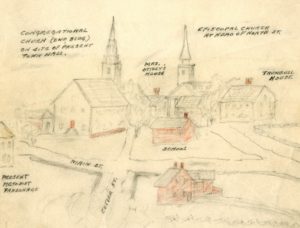
Before 1864, Watertown used the chapel of the Congregational Church as its Town Hall. At that time, the church was located on the site of the 3rd Town Hall and the PO/Health Complex buildings on Route 6.
This drawing, sketched from a viewpoint near the Masonic Hall, also appears as a woodcut in the History of Watertown, published in 1868, and Watertown, Then and Now, published in 1976.
Second Town Hall (1864-1894)
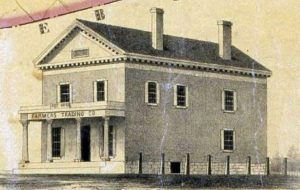
In 1864, a town committee purchased the brick building known as Amos Gridley’s store to be “fitted up” as a Town Hall and served for town meetings until 1894.
Built in 1846, the building has served many purposes over the years:
- 1850s: The Farmers Trading Post
- 1853: Watertown’s first Post Office
- 1864-1895: Town Hall
- 1896-1951: Fire Department
- 1953-Present: Fire District
And the 2nd floor was also used as:
- 1855-1872: Watertown Masonic Hall on 2nd floor
- 1897-?: Kindergarten on 2nd floor
- 1903-1913: Barber Shop
- 1968-2019: Historical Society Museum
During World War II, this building also housed the local alert headquarters.
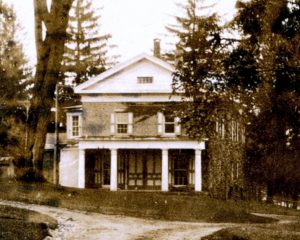
Third Town Hall (1894-2020)
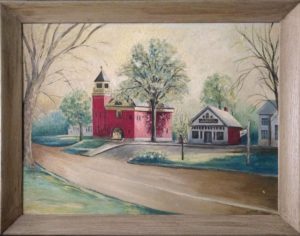
Built in 1894, this classic structure is nothing short of a historic treasure. Throughout the first half of its life in particular, it was the very center of Watertown life for many generations.
Hundreds of town meetings held here resulted in decisions that affected everyday life in our community. Court hearings were held here, marriage licenses were issued, and this is where everyone gathered to celebrate the end of WWI.
The auditorium on the second floor was used for performances of every imaginable type:
- Traveling acts
- Early silent movies
- Plays, concerts, demonstrations and lectures
- Used by Taft School for performances including President Taft’s sons Robert and Charlie
- Watertown High School held graduations, basketball games, and other events
Now that the town has moved on to a new Town Hall, the fate of this landmark is unclear. Its history remains our common legacy.
Fourth Town Hall (2020 – )
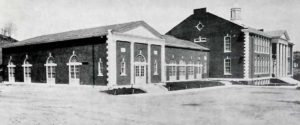
The old Watertown High School was built in 1929. In 1963, after the new high school opened on French Street, the old high school became Heminway Park School, home to 5th and 6th graders.
Today, the building has been transformed into the Fourth Watertown Town Hall.
Elections
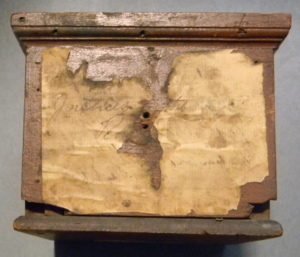
The labels on this hinged ballot box, found in a closet at the old Town Hall, show that it was used at the Second Town Hall:
Justices of Peace
Oct. 4, 1886
Watertown
F.B. Hand
Fred B. Hand was a Cattle Dealer in Watertown living with his wife, Clara, and their daughter, Ella, according to the 1880 U.S. Census. The Census taker did not include street addresses that year, but the family was living near William Hotchkiss. We know the Hotchkiss home was on Skilton Avenue, so we believe Fred also lived in that area of Watertown known as Garnsey Town.
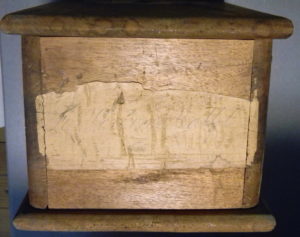
This hinged ballot box, also found in a closet at the old Town Hall, was most likely used in first election after women earned the right to vote in 1920.
Barely legible on one side of the box is this label:

Town records indicate that 252 women were sworn in as Electors on Sept. 18, 1920, less than a month after the 19th Amendment to the Constitution was officially adopted. The first election where they cast their votes was the Watertown Town Meeting held on Oct. 4, 1920. This fall, we will be publishing the full list of women and more about the 1920 Election.
Events
Here are a few groups that used the Town Hall:
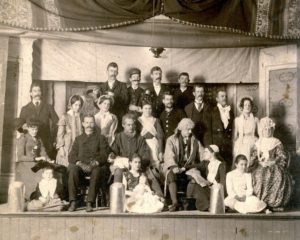
It is believed that this photo was taken in the 3rd Town Hall in the second floor auditorium.
On Riser: 1. Harry West, 2. Fred or Harry Bronson, 3. Robert Magee, 4. George Judd
Standing: 5. Mr. Perkins, 6. Gertrude Welton, 7. Rachel (Wright)* Sanderson, 8. Miss or Mrs? Douglass, 9. John Scott, 10. Dr. Gailey, 11. William Munson, 12. Mary Bronson
Seated: 13. Marie (Hard) Colcord, 14. William Beers, 15. Harry Heminway, 16. Mr. Gardiner, 17. Alice (Hard) Bassett
Seated in front: 18. Helen Atwood, 19. Helen Woodward, 20. Mary (Heminway) Klimpke, 21. Sadie Bryant
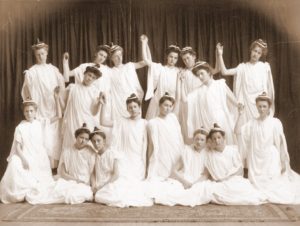
This photo of the Grecian Drill Team directed by Mrs. Wering and Mrs. Judson was taken at the 3rd Town Hall on May 2nd, 1903. The production was held to raise money for the Soldiers Monument dedicated on October 10, 1908.
Back Row: 1. Eula (Cook) Beers, 2. Francis (Atwood) Skilton, 3. Leah Slocum, 4. Mabel (Hickcox) Yard, 5. Fanny (Anderson) Zeid, 6. [Georgia] Eva Prophet
Middle Row: 7. Edith Byron, 8. Susan (Wellan) Copeland
Kneeling: 9. Dorothy Wheeler, 10. Grace Cook, 11. Helen Atwood, 12. Elizabeth (Atwood) Hickox
Seated in front: 13. Edna (Evans) Hosking, 14. Ethel Doolittle, 15. Ina (Atwood) Bassett, 16. Olive (Woodward) Johnson
Stay tuned for more events and history about these historic places.
Notes:
* Women’s maiden names are listed in ( ).
